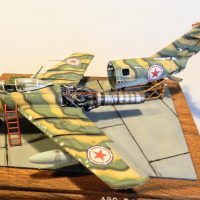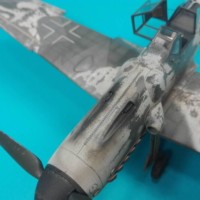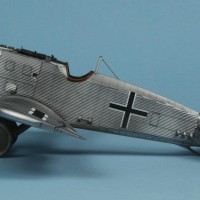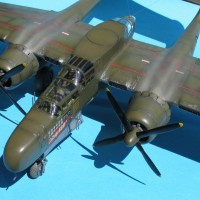de Havilland Heron II by Airfix in 72nd Scale
The DH.114 Heron was developed as a follow-on to the popular DH.104 Dove. It was designed to be used in less developed regions as a more rugged four-engine upgrade. As well as switching to four-engine, the Heron also had increased wingspan and a longer fuselage. Passenger capacity as such was increased to 14. Other modifications for more reliable use included a retractable undercarriage (the Dove had fixed gear), and simpler engines without superchargers (it used the de Havilland Gipsy Queen 60 engine).
The Heron was introduced at the Farnborough Airshow in 1950, and entered service (as a prototype) with British European Airways in 1951. The Heron went on to operate many of the airline's more remote Scottish routes. The first of many overseas deliveries was to New Zealand operator National Airways Corporation in March 1952
The Heron was designed for overseas use in more developing countries with less aviation infrastructure. And that is where it mostly served, although many UK operators also took on small fleets. It was operated by many African, Asian, and Australian airlines. Indonesian airline Garuda placed the largest order of any airline and operated up to 14 aircraft. Puerto Rican airline Prinair was also a major operator, with more than 20 Heron aircraft.
It also served as a transport aircraft with many countries' air forces. In the UK, four aircraft served in the RAF Queen's Flight, replacing the Vickers Viscount. As is common with many aircraft, its use in military roles lasted a long time. Many retiring commercial aircraft found their way into military roles. In total, 149 Heron aircraft were built, with production ending in 1959. One aircraft remains airworthy, with a private owner - G-AORG, which was formerly with the RAF Queen's Flight.
Iconic Duchess of Brittany saved from scrapheap
Excerpted from Emily Hubert News Published: Mar 18, 2021:
JERSEY resident Matt Palmer saved a historic Channel Islands aeroplane from rot to protect it as a heritage asset.
Named Duchess of Brittany, the de Havilland Heron (G-AORG) became subject to insolvency after restoration work took longer than expected.
After hearing this, Mr Palmer submitted a personal bid of £1 to the liquidator, Grant Thornton, to save her for the CI community.
‘It certainly wasn't an easy decision but it felt wrong to leave an important part of our local history to rot given how many people clearly care about her,' Jersey Aero Club treasurer Mr Palmer said.
Before spending several years flying with the Royal Navy, the Duchess flew across the Channel Islands and beyond for Jersey Airlines from the 1950s.
Mr. Palmer aims to return her to the skies as a historic flag-carrying aircraft in airshows, or protect her as a static historical exhibit.
The former Jersey Airlines De Havilland Heron took her maiden flight in 1956, before serving in the Royal Navy as a Sea Herron for almost 30 years. After her service in the military, she was eventually returned home by a team of local pilots.
“She's a remarkable plane, she first flew in the 1950s for Jersey Airlines, after that she was sold to the Royal Navy, where she spent spent 30 flying for Her Majesty's Service before being bought by a group of local pilots and brought back to the Island. They did this remarkable restoration that you can see today.”
Our dear friend, Spiros Pendedekas, previewed this kit on the Modeling Madness website and it caught my fancy, so I picked one up as a "used" kit.
The Build
The emphasis of this build was to produce an airliner livery scheme, so accurate detail was not a major concern. After sanding off the rivets, a notch was filed at the top of the fin for the installation of a radio aerial. The instrument panel and rear bulkhead was dispensed with as was interior painting. The cabin windows and door were cemented in place as was the cockpit floor and seats. Masking was placed over the windows to protect them during the rest of the build.
The instructions are helpful in calling attention to 15 grams of ballast to be installed in the nose. There is not much room for that, but bits of lead did the trick.
Unfortunately, the nose gear trunnion is trapped between the fuselage halves, which almost ensures that it would break off sometime during the build. Fortunately, it can retract if there is room in its well. After the fuselage halves were mated, the strut was retracted as much as possible. So of course, it was knocked off when dealing with the fuselage seam. It was saved for later. The windshield was installed and blended into the fuselage.
Next in the instructions was adding the tail feathers. Again, the rivet detail was removed before gluing. Some filler was needed in the stabilizer seams.
Assembly of the wings follows similar engineering regarding the landing gear. If the struts are extended, the trunnions are trapped in a mounting plate, then the halves glued together. This arrangement proved to be robust and, fortunately, not knocked off. Fit of the wings to the fuselage was good with just a dab of filler needed.
Most of the work filling and sanding during the build occurred when assembling the engine cowls and fitting them to the wings. The instructions called for the props and exhaust pipes to be installed during this step, but were left off for the final assembly. The airframe was ready for painting.
Paint and markings
In my previous build, I used white paint from a rattle can of new Testors and what was remaining in the can was applied on upper portion of the fuselage. MRP paints, which are acrylic lacquer, were selected for the rest of the model save for the nose. The problem with this approach is that the acrylic lacquer will not adhere to the enamel, so the model was masked for the white paint. The first coat of the enamel was splotchy and the second coat resulted in an orange peel finish. (Possibly due to applying it in less than 24 hours after the first.) 800 grit sandpaper dipped in water smooth out the paint. For the third coat, the paint was decanted, thinned, and sprayed through the airbrush. That worked well.
A printed scan of the decal sheet was used to define the mask for the blue on the nose. The compound curve made it tricky and the margin of error was about a millimeter. That area was sprayed with some left-over blue mix that could have been a bit darker, but looks good.
After a couple of days of curing, the fuselage was masked and a coat of Vallejo white primer straight from the bottle was sprayed over the rest of the model, followed by Dark Ghost Gray. The de-icing boots were masked off and sprayed in Rubber. When they were unmasked, the entire model was given a gloss coat, also from MRP.
Anticipating a problem of the 30-year-old decals shattering, they were given a coat decal fix first. They held together well but they needed 10 minutes to separate from the backing sheet. Nor did they maneuver into place easily. The first fuselage stripe broke just behind the lettering, which made it easier to move the pieces. Given that clue, the other stripe was cut in the same place, as were the cheat lines on the nose decals cut at the apex of their curves. Even with those cuts, they didn't handle the compound curve well, even after several applications of Solve-A-Set. A couple of paint touch-ups helped hide the problems.
The next day the model was given another coat of gloss.
Final assembly
Attention was given to the underside bits; exhaust pipes, main wheels, aileron mass balancers and the nose wheel strut and doors. A short bit of styrene rod was installed as an aerial mast and monofilament thread was glued into the notch in the fin and then to the top of the mast. After the two broken props were repaired, the installation of the four of them completed the model.
Conclusion
This is another example of old Airfix, meaning it takes a lot work to make a 21st century model. The overall size and shape look correct, detail is sparse and the fit is reasonably good. About 18 hours went into the project.
It is a coincidence that the kit decals are of the only flight worthy Herron left. Fresher decals for foreign operators and Air-Graphic Models, set # AIR72-023 for RAF Queen's Flight can be sourced from Hannants.











Nice work, John. The Heron is a pleasing design.
Thanks. I think it is a handsome livery.
Well done, John (@jsummerford). Bringing the Airfix kits up to this standard requires a lot of effort and skill. Well done.
Thanks. I toyed with scribing panel lines, but decided that I didn't want to work that hard.
Interesting build, John. Turned out really well.
Thanks. I think it's kinda of an interesting subject.
Fantastic job, John! You certainly took the most out of this old Airfix mold!
Congratulations!
Thanks. Do you think you'll give it a try?
Great work and finish on this old Airfix kit, a real nostalgia trip , interesting right up as well.
Thanks. I get a lot of pleasure out a project by doing research.
This is a very nice Heron, John @jsummerford
Well done.
Thanks. I think the Airfix kit is the only one of the Heron, so some work is required. New decals might make things easier.
I wonder what happened to the Swift Air Herons - they were based out of Sacramento and flew to towns in the nothern part of the state, some of the Central Valley, and the central coast from Monterey down to Santa Barbara. I flew them a few times getting over to San Luis Obispo - a "fun" place to get in and out of because of coastal fog off and on. I remember that central aisle was really narrow, the seats were small, and never get a seat in the front of the cabin because you had to climb over the main spar coming and going. They also replaced the Gypsies with 140hp Continentals.
Nice work on an older kit. "some modeling talent required." 🙂
I didn't know there was an operator in California. Apart from the narrow aisle (I doubt I could walk it facing forward.) it seems that it would be a good puddle jumper in the state.
Thanks for the kind words.
Good looking build, of another not-seen-often subject! Well done.
Thanks. I do tend to gravitate towards more obscure subjects.